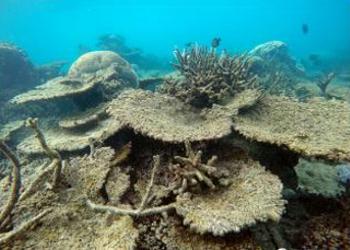
TOWNSVILLE, Queensland, Australia, December 1, 2016 (ENS) – Scientists have confirmed the largest die-off of corals ever recorded on Australia’s Great Barrier Reef.
The worst affected area, a 700 km (435 mile) stretch in the northern region of the world’s largest reef, has lost an average of 67 percent of its shallow-water corals in the past nine months.
Further south, over the vast central and southern regions of the Great Barrier Reef, the scientists were relieved to find a much lower death toll.

“Most of the losses in 2016 have occurred in the northern, most-pristine part of the Great Barrier Reef. This region escaped with minor damage in two earlier bleaching events in 1998 and 2002, but this time around it has been badly affected,” said Professor Terry Hughes, director of the Australian Research Council, ARC, Centre of Excellence for Coral Reef Studies based at James Cook Universit1y.
Dr. Hughes undertook extensive aerial surveys of the reef at the height of the bleaching.
“The good news is the southern two-thirds of the feef has escaped with minor damage. On average, six percent of bleached corals died in the central region in 2016, and only one percent in the south. The corals have now regained their vibrant colour, and these reefs are in good condition,” said Professor Andrew Baird, also from the ARC Centre, who led teams of divers to re-survey the reefs in October and November.
Tourism on the Great Barrier Reef employs 70,000 people, and generates $5 billion in income each year.
“This is welcome news for our tourism industry,” said Craig Stephen, who manages one of the Great Barrier Reef’s largest live-aboard tourist operations.
“The patchiness of the bleaching means that we can still provide our customers with a world-class coral reef experience by taking them to reefs that are still in top condition,” Stephen said.
Another silver lining was revealed in the northern offshore corner of the Great Barrier Reef Marine Park, where the loss of coral was lower than the other northern reefs.
“We found a large corridor of reefs that escaped the most severe damage along the eastern edge of the continental shelf in the far north of the Great Barrier Reef,” said Hughes. “We suspect these reefs are partially protected from heat stress by upwelling of cooler water from the Coral Sea.”
The scientists expect that the northern region will take at least 10-15 years to regain the lost corals, but they are concerned that another bleaching event could happen sooner and interrupt the slow recovery.
Death is only one possible outcome from coral bleaching caused by rising sea temperatures due to global warming. Many surviving corals affected by mass bleaching from high sea temperatures on the northern Great Barrier Reef are the sickest they have ever seen, the scientists said in June.
“We measured the condition of surviving corals as part of our extensive underwater surveys of Australia’s worst ever bleaching event,” said Hughes. “We found that coral bleaching has affected 93 percent of the Great Barrier Reef. While the central and southern regions have escaped with minor damage, nearly half of the corals have been killed by mass bleaching in the northern region.”
Copyright Environment News Service (ENS) 2016. All rights reserved.
© 2016, Environment News Service. All rights reserved. Content may be quoted only with proper attribution and a direct link to the original article. Full reproduction is prohibited.
